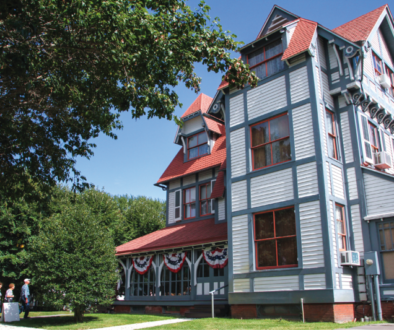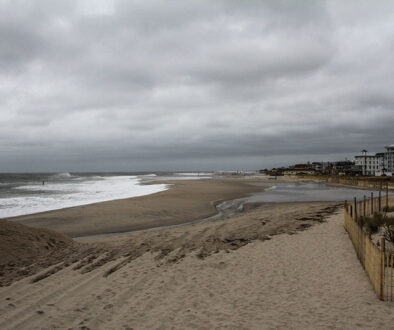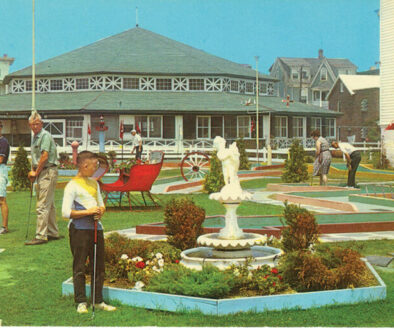Hooked On and In Cape May
It is a Cape May ritual going into a 31st season. A horse-drawn carriage clip-clops along in the Historic District, heads up Columbia, makes a turn onto Howard Street and slows at the big old hotel approaching Sewell Avenue. The driver waves toward the verandas and announces to the passengers, “Oh, look, the Chalfonte hookers are back in town.”
The Chalfonte hookers? Yes, and there they are—sitting in rockers on the hotel’s lacey wrap-around porches. Fabric is spread on frames on their laps, their heads bowed, hooks in hand, pulling thin wool strips through canvas or linen backing, creating works of fabric art. And no, they do not mind being called “the Chalfonte hookers.”

“After all, it is who we are,” says MaryLou Bleakley, the founder of Rugs by the Sea, a traditional rug hooking school that established a home for its annual classes at the Chalfonte Hotel in 1987. MaryLou grew up in Cape May, graduating from the town high school in 1948, back when it was the building that presently houses City Hall.
“There were rug camps on the West Coast, in the Midwest, in New England, but none in the Mid-Atlantic,” says MaryLou. “I had been teaching hooking at various locations and I thought Cape May, my hometown, is a perfect mid-point to draw hookers from New York, Pennsylvania, Maryland, and New Jersey.
“I tried setting up a camp at a few Cape May hotels, but no one wanted us,” says MaryLou. “It was August when I was scoping out a location and nobody had time to understand the concept. But when I walked into the Chalfonte, I was greeted with open arms.” The owner at the time, Anne LeDuc, a teacher, was excited about the prospect of accommodating a fabric art school in September, historically a down time at the hotel.
“I wanted Cape May for my school because it is an interesting town. There are so many things to do besides just hook a rug,” MaryLou says. “The Chalfonte is a perfect place for us. The dining room with its many long windows transforms into a large studio. There is ample space for our supplies of fabric, the cutting machines, floor lights for our close work, plenty of chairs and tables to meet our comfort needs. And, the verandas, with the rockers and sea breezes, are beloved. The verandas are the best spot in the world to sit and hook.”
Rug hooking and the circa 1876 Chalfonte go together like tea and honey. Both are rich in history and stories.
Rug hooking in North America, in its infancy, was a craft of poverty. In the early 1800s when machines started making rugs, the wealthy covered their floors with newly produced colorful carpets. Poor women, meantime, recycled burlap sacking that had contained grain, tobacco, tea or coffee as backing for rugs they created by hand. They used every sort of scrap—be it old long underwear, used blankets, shirts, overalls, socks, calico dresses—to be cut or torn into uniform thin strips. These spaghetti-like pieces of fabric were then looped through backing with a long hook to form knotted pile which, when completed, became a floor rug, chair mat, bed covering, or wall hanging. Sizes vary from a few inches for a cup mat to several feet for a room size.



Most rug hooking in North America dates back 200 years or more to communities in New England—especially Maine and Massachusetts—and the Maritime Provinces of Canada. In the 1920s and 30s there was a resurgence of interest in hooked rugs. Cottage industries developed in some Canadian fishing villages providing poor families skilled in quality hooking an opportunity to earn money in winter months. Now the craft enjoys international popularity.
The subject matter of hooked rugs is endless. Design patterns feature flowers, fruits and vegetables, family pets, farm and wild animals, lighthouses, boats, churches, sunrises and sunsets, holiday motifs, portraits, and all sorts of geometrics. Many hookers use commercially designed patterns; others develop their own designs.
Rug hookers are always looking for new ideas that can be translated into rug designs. Norma Batastini, a prolific, popular rug designer who has been co-director of the Chalfonte hooking classes for 16 years, says that in the 1990s personal story rugs became popular. The idea came from a group of women in Turkey who designed folklife rugs portraying the story of a person or a family and the multiple images inspired by their daily routines and surroundings. Norma, whose Heart in Hand Studio is located in Glen Ridge, New Jersey, was among the first to design a folklife rug and teach the technique in this country, encouraging students to hook their own stories. Norma writes and is an advisor for the bible of the craft, Rug Hooking Magazine. It features stories of hookers, their techniques, photos of their work, plus tips.
Deanne Fitzpatrick, a teacher from Nova Scotia, wrote recently: “If you want to reflect the life around you in your rugs, then you must observe that life as if it were a movie that you love. You have to pick up on each detail, all the subtleties, and you have to make note of them. The details become more interesting and your life becomes richer for it. That is the beauty so many people find in rug hooking.”


Rug hooking is all about detail. Linda Woodbury, co-director of the Chalfonte workshop, explains there are two different styles based on the width of the fabric. There is the fine cut, just 3/32″, and a wider cut of up to 10/32″. The finer cut makes for a tighter, more realistic image while the wider is used in more abstract primitive designs. “The strip cutting machine looks like a tool for making pasta,” says Linda. “Some hookers use recycled clothing from thrift shops and rummage sales, others prefer all new wool, still others use blends, or just t-shirts. Color is very important. Some dye their own fabric, others focus on collecting colors from specific sources. Patience is a prerequisite. It usually takes about 10 to 12 hours to make a square foot of hooked pile.”
Last year, the Chaltonte hookers had 120 students who hooked 100 finished rugs. This year, because of popular demand, Linda and Norma have extended their Chalfonte workshop to a third week. Most of the hookers are women, but there are also men who excel. One of the most sought-after teachers is Doug Rankin of Halifax, Nova Scotia. He says he didn’t know what a hooked rug looked like until his wife Anne took him to an exhibit. When Anne decided to learn to hook, Doug accompanied her to class in 1995, and was inspired to become skilled while visiting rug exhibitions around New England. Doug will be teaching a class the first week of this season’s Chalfonte workshop.
His class is unique. His wife has the license for producing rugs from the paintings of famous Canadian folk artist Maud Lewis [1903–1970]. Many of her paintings are of Nova Scotia outdoor scenes around the tiny community of Marshalltown on an isolated narrow slice of land between the bays of Fundy and St. Mary’s, where she lived. Her mobility and dexterity were compromised due to disability from birth and juvenile rheumatoid arthritis. She painted what she saw: bright blue skies, windswept vistas, boats bobbing on the water, horses pulling a sleigh, family pets, garden flowers. The colors are vibrant because Maud Lewis seldom mixed paints. Sometimes she used house paint. Or, she used oil-based paint directly from the tube. Her first paintings were Christmas cards she sold for a quarter. Later she sold landscapes to tourists for two dollars. Now her paintings sell for up to $20,000.


Her life and art were made famous in the 2017 movie Maurie, starring Sally Hawkins and Ethan Hawke. Maudie was left to live in extreme poverty with a quarrelsome aunt. When Everett Lewis, a reclusive fish peddler, posted an ad for a housekeeper in the village grocery store, Maudie took the job, moving in with him to a tiny wooden shack with his two dogs and chickens. Painting with a gnarled hand, suffering abuses from Lewis, who became her husband, she covered the walls, windows, stove, staircase, breadbox and window boxes with paintings. She couldn’t afford canvas. She used mostly wallboard and painted on pieces of wood she scavenged. She tried to paint every day no matter her pain or the frequent fierce weather.
“A Visit with Maud” is the theme of the class Doug Rankin will be teaching this year at the Chalfonte. Doug and his wife have specialized in interpreting Maud’s paintings into hooked rug patterns through the auspices of the Art Gallery of Nova Scotia, where 55 pieces of Maud’s art and her restored small cottage are on exhibit. The cottage was rescued from deterioration, her interior art saved and moved to the gallery in 1998. In a rare interview with the Canadian Broadcasting Corporation before she died, Maud said she seldom left her little house. “Contented right here in this chair,” she said. “Ain’t much for travel anyway. As long as I’ve got a brush in front of me, I’m alright.”
Doug Rankin shares stories of Maud’s spirit and isolated life as he instructs about her painting techniques and color, and translating that into hooking a rug of her art. “You can feel her joy coming through as you hook one of her designs,” says Doug. “The happiness of her art hardly hints at the difficult life she led.”
Producing a design to hook is an art in itself. “I draw out the image first on regular paper,” says Norma Batastini. “Then I transfer the design to a thick piece of paper with a grid which helps to square it up and keep it even. If it’s for a large rug, I take the drawing to an office supply store to magnify. Then I transfer the design to a backing at my light table and hand draw every image on the backing. My smaller designs sell for $25, the larger for $100, and the very large may be several hundred dollars. Generally the colors for the hooking process are not included. Deciding color is a very creative, interesting process. That’s a reason why students come to the Chalfonte and other workshops—to get ideas for color. There are many formulas for dying wool. Some dye their own, others buy colors.”
Norma says her sense of color and design began developing at an early age when she absorbed what was happening on her mother Ellen Savage’s easel. Ellen has been a lifelong artist, painting in oils and watercolors. When Norma got hooked on hooking rugs, Ellen became curious, took lessons and became expert. Her most famous rug is a 36” by 53” stylized image of the Chalfonte Hotel designed by Beverly Conway, especially for Rugs by the Sea’s 20th anniversary. “It took me almost six months to finish the project,” said Ellen. “I stayed with it almost every day except for the two weeks I took off when I got a stiff neck.” At age 87, she remains a regular at the Chalfonte workshops, and still paints as well.

Tracy Jamar, a veteran at restoring antique hooked rugs, described the craft that has become an art in an article, “A Few Loops of Hooked Rug History.” She notes that handmade rugs are an example of how a humble craft, born of leftovers, can produce something beautiful and useful and begin a new life. Hooked rugs of the past can be a physical registry of the life of the maker—literally containing shirts off backs, socks off feet.
Today’s hookers don’t need to rely on hand-me-downs, but the joy and challenge of producing a useful art is timeless and universal.



